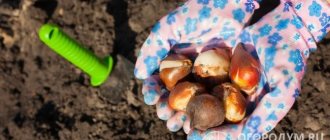Gladioli are a garden decoration. But few people decide to grow this beautiful flower, all because gladioli require special care.
At the end of each summer season, flower tubers must be dug up and stored. The easiest way to store gladioli bulbs at home is in the refrigerator.
Information on how to properly prepare flower tubers, how to store and plant them in the new season will help you achieve the desired result - lush flowering in the spring.
We will tell you in the article whether and how to properly store gladioli in the refrigerator.
Are bulbs allowed to be stored in the refrigerator?
You can store gladioli bulbs in the refrigerator in winter. This is very convenient, as the refrigerator maintains ideal storage conditions.
Optimal storage conditions:
- air temperature - no more than 4°C;
- humidity -75%;
- lack of sunlight;
- good ventilation.
Warm storage activates the growth of the bulb, and prolonged exposure to low air temperatures causes freezing of the seed. Storing gladioli bulbs in the freezer is strictly prohibited!
Preparation
must be properly prepared before storing in the refrigerator
The dug up planting material is carefully sorted (only strong, dense tubers without signs of rot or other damage are selected).- The sorted tubers are dried.
To do this, planting material is folded in one layer into mesh boxes, after which it is sent to dry in a warm, dry place (the air temperature should not fall below +24°C). Drying lasts for at least forty days (at the end, the babies are removed from the tubers, the dried stem and roots are cut off). - The bulbs are dipped in a weak solution of manganese (a few granules per liter of water are enough) for thirty minutes, after which the tubers are sent to dry again for another week. Treating the bulbs with antiseptic solutions is a very important step; it helps preserve planting material during storage from fungal and bacterial infections.
Flower tubers prepared for storage must be immediately sorted into varieties so that in the spring, when planting, there is no confusion.
Selection of quality corms
Bulbs of each variety need to be further sorted to get rid of material with signs of rot or drying out. At the same time, the dug up children are also sorted; bulbs that are too small will not survive the winter. Their minimum size should be at least 6–8 mm.
In this case, only babies that have covering scales will be stored well. It is better to throw away old bulbs; they will no longer produce full blooms. Young large corms have a regular round shape, their diameter is usually equal to their height.
How to preserve planting material until spring?
Before loading the bulbs into the refrigerator, each one is wrapped in newspaper (preferably in two layers) and placed in a plastic bag with holes for air. Store planting material in the bottom drawer of the refrigerator intended for vegetables and fruits.
If there is no free space in the vegetable container, a bag of gladioli bulbs can be placed on a glass shelf located on top of the vegetable box.
If flower tubers begin to germinate during storage, the bag must be moved to the top shelf (lower temperatures will slow down the development of a new flower).
During storage in the refrigerator, gladioli bulbs are inspected for spoilage at least once every two weeks. Tubers with the slightest signs of rot are immediately put aside, otherwise all planting material will very quickly become covered with spots of rot.
Results
Based on the information presented, we can conclude that storing gladioli in the refrigerator can be quite simple. The main condition is the presence of a spacious box. Designed for storing vegetables. If there is no such thing. It is worth considering other options that allow you to preserve planting material in an apartment. Gladioli can be kept on the balcony or directly indoors, but there is a risk of their premature germination, so such methods are not often used.
When sending planting material for storage, you need to remember that all bulbs need to be isolated from each other. Otherwise. If one element is affected by rot, all specimens may be lost. Also during storage you need to monitor the condition of the bulbs. They should be dense, without traces of bacterial damage. If any signs of spoilage are detected, the onion should be isolated.
Do not forget that the bulbs need to be prepared in a timely manner for planting in the ground. To do this, they need to be removed from the refrigerator 3-4 weeks before the intended planting. The material must be cleaned and treated with a fungicide. If all of the above conditions are met, the gardener will be able to achieve exuberant flowering of gladioli, which occurs at the end of summer.
Video: preparing gladioli bulbs for planting
https://www.youtube.com/watch?v=5saL0OJqu4w
Video: how and where to store gladioli in winter
Do you want to understand better than others?
- Preparing and storing ginger in the refrigerator - Ginger root is a spice characterized by unique taste and medicinal qualities. It is used to create meat dishes, desserts, prepare cold tea or...
- Freezing grapes: preparation and storage - The article provides recommendations for freezing grapes for the winter and describes a method for winter storage of grape cuttings in the refrigerator. Why freeze grapes in winter...
- Rules for long-term storage of cranberries in the refrigerator and without it - Cranberries are a storehouse of useful substances that need to be preserved throughout the winter. It is important that cranberries do not lose their beneficial properties when frozen and long-term storage at home...
- How to store dried mushrooms at home - Drying is one of the most popular options for stocking up on dried mushrooms for future use. Rules and methods for storing homemade preparations, terms and options for use in cooking...
- How to keep lemons fresh at home - Thanks to the piquant taste of lemon and the presence of many beneficial micronutrients in its composition, it is a common ingredient in various dishes and drinks. Many even grow...
When and how to take it out after winter storage?
Gladiolus bulbs are taken out of the refrigerator thirty days before planting (the necessary period for the formation of full-fledged arrows and pecking of the bud).
Considering that it is recommended to plant bulbs when the air temperature in the morning reaches at least 10°C (beginning of May), it is necessary to remove flower tubers from the refrigerator no later than the beginning of April.
After removal from the refrigerator, each onion is freed from scales and sorted by size and appearance. Quality tubers are shiny, pale yellow or cream in color, with dense white root buds. Wrinkled, shriveled, and spotted bulbs are planted separately.
After the planting material has been sorted, the tubers are placed in boxes (in one layer), tops up . The box is placed in a dry, warm, dark place. After 2-3 weeks, when the dormant buds have hatched and reached at least 4 cm, the flower tubers can be planted in the ground.
Gladioli tubers planted in the ground immediately after refrigeration will take root, but you should not expect lush flowering from such plants.
Botanical properties of gladiolus
The sword-shaped, pointed leaves of the gladiolus give the plant its name – gladius means “sword” in Latin. But what this plant is really valued for is its spike-shaped, strict and slender inflorescences. They can be terry or simple, one-sided or double-sided, and thanks to breeders, a huge variety of shades have appeared: from classic white, pink, red to unusual green, blue and purple.
During the growing season, the corm produces 1 peduncle. The plant shoots out an arrow, on which flowers then bloom. At the same time, next to the main corm, another one is formed - a young, replacement corm with small children that look like white bubbles.
Important! Sometimes 2-3 peduncles grow from one corm at once. Then 2-3 arrows with flowers appear simultaneously and, accordingly, 2-3 replacement corms with children are formed. In the spring, before planting, inspect the corms. If you notice not one, but 2-3 sprouts on them, then choose the strongest one and leave it, remove the rest.
How to plant?
Immediately before planting, gladiolus bulbs are soaked either in a special solution to strengthen the root system (sold in specialized flower shops) or in clean warm water. After six to eight hours of soaking, the tubers are saturated with moisture , after which they can be planted in the flowerbed.
The location for future planting of gladioli must be chosen in sunny, open areas (the flower loves the sun and warmth) with loose soil. Additionally, each hole is fertilized with organic fertilizer, ash, and sand is added. Seven days after planting, flower seedlings are fertilized with humus.
For active flowering, gladiolus needs a large amount of light, air and free space. Therefore, when planting, a distance of at least 15 cm must be left between the holes.
Alternative options
In order for gladioli bulbs to retain their vitality and delight with their lush color in the spring, it is necessary to observe optimal storage conditions : low air temperature and high humidity.
There are several options for how, in addition to the refrigerator, to organize storage of bulbs in the winter at home.
Waxing
Coating gladioli bulbs with paraffin is a reliable way to preserve planting material in your apartment until spring. The paraffin shell reliably protects the bulbs from drying out and blocks the growth process.
Algorithm of actions:
- A paraffin candle is heated in a water bath.
- A gladiolus bulb is dipped into melted paraffin (temperature no higher than +70°C), after which it is immediately transferred to cold water.
During the waxing process, it is necessary to ensure that the bulb is completely covered with an even layer of wax. Otherwise, air penetrating through the cracks can cause the tuber to dry out.
To wash off the paraffin, just hold the onion in warm water for a few minutes. Attention: do not brush off the wax; this may damage the gladiolus tuber.
On a glazed loggia or balcony
A good place to store gladioli bulbs in an apartment in winter is a covered loggia. Planting material is sorted, laid out in a thin layer in cardboard boxes and placed on a stool or table. A good place is the window sill of a wooden window frame.
During storage, the required air temperature in the loggia is maintained by opening the window or doors to the room. Regular ventilation helps maintain the required level of air humidity .
During prolonged winter frosts, boxes with flower bulbs are covered with thick woolen rags and moved closer to the balcony door.
Never place boxes with gladioli bulbs on the concrete floor of the loggia (there is a high probability of freezing the planting material).
It is strictly forbidden to store gladioli bulbs:
- in the bathroom (high humidity is the main cause of rotting of tubers);
- without husks (protective dry leaves can be removed from the bulbs only after drying, otherwise the risk of plant infection increases sharply);
- in sealed packaging bags (lack of ventilation during storage is the first step to rotting of the gladiolus bulb);
- in direct sunlight (the sun dries out gladioli tubers, making them unsuitable for planting).
Never store assorted gladioli bulbs in the same container. Firstly, when planting, it will be simply impossible to figure out which variety is where, and secondly, the close contact of healthy and rot-infected tubers leads to rapid deterioration of all seed material.
We meet deadlines
To direct the strength of the blooming gladiolus to the formation of healthy bulbs, they should be cut when the flowers are partially open.
Every gardener would like to admire his flower garden for as long as possible, but if you neglect this advice, the number of healthy plants will decrease next year. The deadline for removing flowers is 2 weeks before harvesting. But calculate the time not only according to the region of residence, but also based on the weather. If it rains in the fall and the average temperature is around 10°C, dig up the bulbs earlier than the end of September.
In the south of Russia, most gardeners remove corms in mid-October, and some leave them in the ground, covering them. To avoid risks (winter may be too frosty), it is still recommended to store the tubers at home.
Adviсe
To prevent gladioli tubers from taking root during storage, before storing them in the refrigerator, they are thoroughly dried and placed in gauze nets.
Alternatively, the tubers can be wrapped in toilet paper (as soon as the paper starts to get damp, it is changed).
Gladioli bulbs are dug up for storage thirty days after the flower shoots wither. There is no point in keeping the tubers in the ground. High humidity and low temperatures activate the process of tuber rotting and the proliferation of bacteria and fungi.
If it is not possible to wait for the gladiolus to bloom, first of all, cut off the still blooming arrow, and after fifteen days, dig up the tuber. It is better to dig up bulbs not with a shovel, but with a pitchfork . This will protect the planting material from damage by the sharp blade of the bayonet.
Treatment of tubers from diseases and pests
Newbie gardeners are often interested in the question of whether it is necessary to peel the gladiolus bulb before storing? After a month, you should clean the gladiolus bulbs from the upper scales and remove the old corms along with the roots. If necessary, you can use a sharp knife. It is easy to distinguish, the old corm is brown in color. When this is not done, it will die and infect the bulb.
Small baby tubers should be divided before planting. Trim the dried stems to a height of 1 cm.











